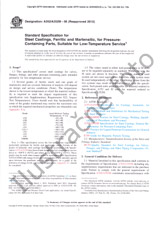Potrebujeme váš súhlas na využitie jednotlivých dát, aby sa vám okrem iného mohli ukazovať informácie týkajúce sa vašich záujmov. Súhlas udelíte kliknutím na tlačidlo „OK“.
ASTM D6105-04(2019)
Standard Practice for Application of Electrical Discharge Surface Treatment (Activation) of Plastics for Adhesive Bonding
NORMA vydaná dňa 1.6.2019
Informácie o norme:
Označenie normy: ASTM D6105-04(2019)
Dátum vydania normy: 1.6.2019
Kód tovaru: NS-951555
Počet strán: 5
Približná hmotnosť: 15 g (0.03 libier)
Krajina: Americká technická norma
Kategória: Technické normy ASTM
Kategórie - podobné normy:
Anotácia textu normy ASTM D6105-04(2019) :
Keywords:
discharge, corona treatment, modification, polymer, surface, surface treatment,, ICS Number Code 83.140.01 (Rubber and plastic products in general)
Doplňujúce informácie
| Significance and Use | ||||||||||||||||
|
5.1 Bonding of many polymeric substrates presents a problem due to the low wettability of their surfaces and their chemical inertness. Adhesive bond formation begins with the establishment of interfacial molecular contact by wetting. Wettability of a substrate surface depends on its surface energy. The surface activation with electrical discharges improves wettability of polymers and subsequent adhesive bonding. The surface activation with electrical discharges results in addition of polar functional groups on the polymer surface. The higher the concentration of polar functional groups on the surface the more actively the surface reacts with the different polar interfaces. 5.2 To achieve a proper adhesive bond the polyolefin substrate's polar component should be raised from near zero to 15 to 20 mJ/m2. 5.3 The pre-treated surfaces are ready for application of the adhesive immediately after the treatment. |
||||||||||||||||
| 1. Scope | ||||||||||||||||
|
1.1 This practice covers various electrical discharge treatments to be used to enhance the ability of polymeric substrates to be adhesively bonded. This practice does not include additional information on the preparation of test specimens or testing conditions as they are covered in the various ASTM test methods or specifications for specific materials. 1.2 The types of discharge phenomena that are used for surface modification of polymers fit into the general category of nonequilibrium or non-thermal discharges in which electron temperature (mean energy) greatly exceeds the gas temperature. 1.3 The technologies included in this practice are:
Note 1: The term “corona treatment” has been applied sometimes
in the literature to the different electrical discharge treatment
technologies described in Section 9. This practice defines each electrical
discharge treatment technology at atmospheric pressure presented in
Section 9 and draws the
necessary distinctions between them and corona discharge. See Test
Method D1868 for “corona
discharge.”
1.4 The values stated in SI units are to be regarded as the standard. 1.5 This standard does not purport to address all of the safety concerns, if any, associated with its use. It is the responsibility of the user of this standard to establish appropriate safety, health, and environmental practices and determine the applicability of regulatory limitations prior to use. 1.6 This international standard was developed in accordance with internationally recognized principles on standardization established in the Decision on Principles for the Development of International Standards, Guides and Recommendations issued by the World Trade Organization Technical Barriers to Trade (TBT) Committee. |
||||||||||||||||
| 2. Referenced Documents | ||||||||||||||||
|




 Cookies
Cookies
